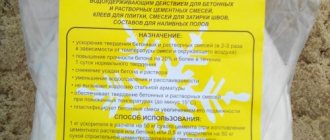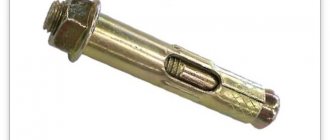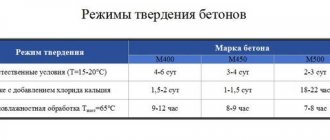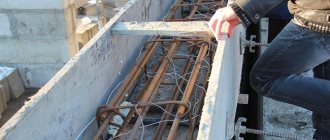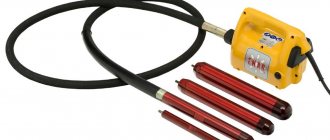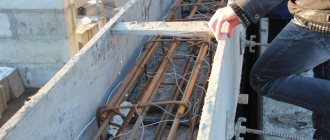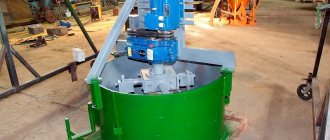Pouring concrete in winter has its own difficulties. The main problem is the normal hardening of the solution, the water in which can freeze and it will not gain technological strength. Even if this does not happen, the low drying rate of the composition will make the work unprofitable. Warming up the concrete with a PNSV wire will help resolve this issue.
Electric heating of concrete in winter is the most convenient and cheapest way to achieve the desired hardness of the material. It is permitted by the standards of SP 70.13330.2012, and can be used when performing any construction work. After the concrete hardens, the wire remains inside the structure, so the use of cheap PNSV provides an additional economic effect.
General description of the technology for electric heating of concrete with wire
When using a heating transformer, the wire acts as a heating cable for reinforced concrete structures.
The thermal energy transmitted through the steel core of the PNSV wire is transferred to the concrete mass, preventing concrete from freezing at low winter temperatures, ensuring its necessary strength. To warm up 1m³ of concrete, approximately 50-60 m of PNSV wire is required. You will also need AR wires and a KG cable.
The most economical option is to use a single-core heating cable PNSV 1x1.2, a PNSV 2 wire or a two-core PTPZh wire for heating. The cost of heating concrete will be about 700 rubles per 1 cubic meter. meter with rental equipment from the STROOITELI company.
One 80 kW heating transformer - KTPTO-80, TSDZ-80 or SPB-80 - is designed to heat 40-50 cubic meters. meters of concrete.
The efficiency of heat treatment at subzero temperatures is increased by using heat-insulating tents or thermomats.
Common heating methods: main features, pros and cons
To ensure uniform heating of concrete, additional insulation is required. You can also create a thermos around the object.
Electrode
Concrete solution is capable of conducting electric current. Electrodes are placed not only inside the mixture, but also on its surface. An electric field is formed after connecting the elements to the transformer. At this time, the concrete warms up. This method is easy to use and provides a high efficiency. However, it requires lengthy preparation.
Scheme of heating concrete using electrodes.
To avoid loss of moisture and heat after fixing the electrodes, the surface of the solution is insulated. It is forbidden to use direct current when heating, since the water does not crystallize and the mixture does not harden. For work, string, plate, strip or rod electrodes are used.
Contact (electric heating of the formwork)
This method involves the construction of formwork. Heating elements are installed before pouring the finished solution. The concrete is heated from the outside.
You can make formwork yourself, but the process is labor-intensive. The disadvantages of such heating are low efficiency (efficiency factor) and high cost.
If the configuration of the concrete structure is complex, its installation is difficult.
Scheme of contact electric heating of formwork.
Thanks to the placement of the heating sections on the outside, they can be replaced if necessary. The formwork is reused. Construction work is allowed to be carried out at temperatures down to -25ºС.
Induction
This method is used to work with reinforced structures. An insulated wire is wrapped around a reinforcement rod, which heats up. The number of turns and cable cross-section are pre-calculated. Alternating current is passed through it. The concrete layer is heated evenly. This method has limited use and is difficult to use on your own.
Heating concrete using the induction method.
Infrared
Infrared radiation is directional. This heating method is only applicable for a small layer of concrete in a horizontal plane. It is easy to install and affordable.
Changing the interval between the heater and the concrete surface allows you to adjust the intensity of thermal radiation.
Infrared heating is characterized by low energy consumption and ease of installation. In this way, concrete can be heated through the formwork.
Schemes for heating concrete with infrared rays.
Evaporation of water is a disadvantage of the method. It can be eliminated using a waterproofing film. Thermomats are connected to a regular power supply. The maximum heating temperature is +55ºС.
Thermos method
To speed up the hardening of concrete, a greenhouse made of tarpaulin can be built above the structure. Heat guns are installed inside the tent to ensure the required temperature. After warming up, the greenhouse is dismantled. No additional equipment required. The thermos method is optimal if the treatment area is small.
The technology of heating concrete using the thermos method is simple and economical.
Concrete heating service
We propose to implement the most effective, reliable and safe method of heating concrete - electric heating. The heating element is a PNSV wire or electrodes, depending on the design.
- Transformer KTPTO-80 1500r/day
- Diesel generator 65kW3000r/day
- Concrete heating service from RUR 700/m3.
- Delivery from 7000 rub.
- Cable products according to calculation
The complete heat treatment transformer substation (KTPTO-80) is designed for heating concrete mixtures, frozen soil, and also as a power control element at a construction site. Rent of a package transformer from 1000 rubles per day. Company BUILDERS©
Short description
Rental cost: 1000 rubles per day from 30 days or 1500 rubles per day from 5 days
The indicated price does not include cable products, as well as electrodes required when renting a power supply unit for heating concrete with electrodes.
Rental prices are 10% lower at the STROITELI ® company when placing an order for an amount of 40 thousand rubles or more, more details.
Laying schemes
The simplest cable laying pattern is the “snake”. It resembles the installation of a heated floor system. In this case, electricity is saved, but the maximum volume of the concrete structure is heated. The bending radius is 5-10 working diameters. The wire is laid without tension.
Cable laying technology for heating concrete.
When connecting, a “triangle” or “star” circuit is used. In the first case, the wires are formed into 3 identical groups. They are connected in parallel and output to 3 output points. If the load is distributed according to a “star” pattern, then 3 segments of the same length are tied into 1 knot, and the rest are connected to the power station. All contacts are insulated.
Concrete heating station KTPTO-80 for rent
- Transformer: TMTO-80
- Voltage: 380V
- Power: 80 kW
- Weight: 665 kg
- Rent from 5 days
Rent per day
Month
Pledge
1 500.-
30 000.-
30 000.-
The complete heat treatment transformer substation (KTPTO-100) is designed for heating concrete mixtures, frozen soil, and also as a power control element at a construction site. Rent of a package transformer from 1000 rubles per day. Company BUILDERS©
Installation of PNSV
Here is a brief guide to the standard methodology:
- We select the wire diameter according to the technical data sheet, as a rule it is 1.20-4.0 mm. If you plan to heat reinforced structures, it is recommended to use PVC insulation, since it is more durable. For unreinforced structures, it is allowed to use polypropylene-coated wire.
- Cutting is done in segments of equal length, after which they are rolled into a spiral (Ø 30.0-45.0 mm).
- Spiral threads are laid in a reinforcement frame or they are placed in a plywood or wooden frame (formwork).
- The characteristics of the PNSV do not imply its operation as a heater outside the concrete mixture. Under such conditions, it immediately fails. To correct the situation, use any mounting wire of a larger cross-section, which is connected to the terminals of the segment. An example of how to connect PNSV using cold ends
- After the formwork is poured with concrete mixture, wait until it begins to set, after which the transformer substation is turned on. With its help, the required temperature is set by increasing or decreasing the voltage.
Please note that the principle and layout of PNSP, PNBS, PTPG are practically no different from PNSV. Using a welding machine as a PT
Using a welding machine as a PT.
This method of heating is quite possible; we will give an example of how this method can be implemented. Let's say we need to fill a slab with a volume of 3.7 cubic meters, at an outside temperature of 10°C. For this purpose, you will need a 200.0-250 ampere welding machine, current measuring clamps, PNSV wire, cold ends and fabric insulating tape.
We cut eight segments of 18.0 meters each, each of which can withstand a current of up to 25.0 A. We will leave a small margin and take eight such segments to connect to a 250.0 A welding machine.
We connect a twisted installation wire to each output of the segment (we connect the cold ends). We are laying the PNSV, its diagram will be given below. It is advisable to connect the cold ends (plus and minus separately) using a terminal block placed on a textolite or any other insulating material.
Connecting the PNSV to the welding machine
Having completed the filling, we connect the direct and reverse output of the device (the polarity does not matter), having previously set the current to a minimum. We measure the load current on the segments; it should be about 20.0 A. During the heating process, the current strength may “sag” a little; when this happens, we increase it during welding.
Concrete heating station KTPTO-100 for rent
- Transformer: TMTO-100
- Voltage: 380V
- Power: 100 kW
- Weight: 725 kg
- Rent from 5 days
Rent per day
Month
Pledge
1 500.-
30 000.-
30 000.-
Check availability: By phone.
Call or send a request via SMS or WhatsApp number.
By email
24/7 acceptance of orders by email: no waiting and guaranteed processing. You will receive an accurate calculation of your order for renting equipment and tools by email or using the contact information you provided.
Heating duration
The duration of warm-up depends on the speed at which 30-50% of the design strength is achieved. The standard solution processing time is 4-7 days.
The calculation of the concrete heating time depends on the temperature of the structure.
Laboratory tests will allow you to more accurately determine the period. Sample castings are examined, which harden under the same conditions as the main structure.
To choose the right heating method, you need to calculate the total costs. Additionally, you can use antifreeze additives that reduce the hardening time.
Rent of generator 60 kW AD-60S-T400-R
- Type: diesel
- Power: 60 kW
- Voltage: 380V
- Tank volume: 175 l
- Working time: 10 h
- Rent from 5 days
Day
Month
Pledge
5 000.-
130 000.-
200 000.-
Check availability: By phone.
Call or send a request via SMS or WhatsApp number.
By email
24/7 acceptance of orders by email: no waiting and guaranteed processing. You will receive an accurate calculation of your order for renting equipment and tools by email or using the contact information you provided.
Rent with operator: +5 000 .- /day
Features of PNSV heating wires
The PNSV cable is a steel core with a diameter of 1.2 to 3 mm and a cross-section of 0.6 to 4 mm2, covered with PVC or polyester insulation. Thanks to this insulating material, the wire does not bend or break and is resistant to fire.
Most often, electric heating is carried out using wires with a minimum diameter of 1.2 mm. However, practice shows that it is better to use 3 mm PNSV, especially if you plan to manually compact the mortar. The fact is that the insulation of such a cable will be much stronger, so in the event of poor-quality power supply, the likelihood of overheating will be minimal.
It is also worth paying attention to another distinctive characteristic of heating cables of this type - the presence of “cold ends”. These branches extend beyond the boundaries of the concrete slab. For “cold ends”, automatic reclosure wires (aluminum conductors) are used, connecting the cable itself to the supply route.
Heating concrete is more profitable with us
- Free calculation
- 24-hour duty and temperature control of the concrete mixture,
- It is possible to rent individual items of equipment,
- Discount on services when ordering turnkey heating,
- Delivery and installation of equipment in the designed position,
- Setup and switching (warm-up service) from 700 RUR/m3.
Note: when ordering for a long period or renting several pieces of equipment from the STROITEL company, you receive a discount. See: discount on orders over 40,000 rubles.
Our company is involved in monolithic construction work and also offers equipment for rental. We have over 100 units of machines and equipment that can completely cover the needs for concrete heating services. We will calculate and deliver everything you need throughout Moscow and the Moscow region.
Address in Moscow: Selskokhozyaystvennaya street, 43, building 1
— View conditions for renting other construction equipment.
Location and fixation of heating elements
When installing wires, observe the following rules:
- The cable between the walls of the formwork is fixed so that it is located at a depth of at least 20 cm from the surface of the concrete structure.
- Wires are installed in such a way as to avoid insulation breaks. Curves should be smooth. The maximum permissible radius is specified in the cable specifications. It is better to use materials with a bending margin.
- The conductors are laid out according to a previously prepared drawing to distribute the heat evenly.
After this, they are fixed with a thin flexible wire that can be twisted by hand. It will not damage the insulating shell. Instead of wire, it is allowed to use plastic clamps.
The concrete mixture is compacted manually or using a special vibrating tool: this way it will not damage the wires. After this, the wire strands are interconnected and connected to a transformer or directly to the power supply.
PNSV cable heating technology
For effective heating, precise power control is necessary. Otherwise, insufficient or too strong heating of the heating wire can cause destruction of the monolith. If overheated, the insulating shell may melt, and the wire strands will then come into contact with the fittings, resulting in a short circuit. To prevent this from happening, special wiring diagrams for the heating conductor are used.
Connection diagram options
As a result of theoretical developments and experimental studies, a voltage of 70 volts was determined, at which the PNSV “works” most effectively with the hardening solution. To create optimal heating conditions, you will need a step-down transformer.
Transformer step-down substation
Before installing electrical wiring, calculate the length of the wire. Then the laying diagram and method of connecting the cable, the value of the operating output voltage are determined, taking into account the volume of the concrete solution, the ambient temperature and the size of the monolithic structure. In order not to get bogged down in complex calculations, use an online calculator that takes into account all of the above parameters. The two most common cable laying and connection schemes are used: star and triangle.
Connection options